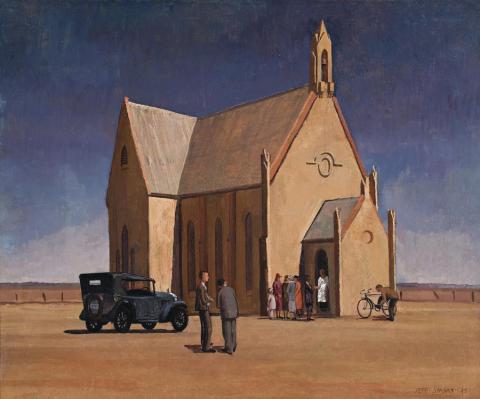SUNDAY MORNING SERVICE, 1945
Jeffrey Smart
oil on canvas
51.0 x 61.0 cm
signed and dated lower right: JEFF’ SMART 45
David Jones Art Gallery, Sydney
Australian Galleries, Melbourne (label verso)
The Hicks Family Collection, Melbourne
Jeff Smart, Jacqueline Hick, David Jones Art Gallery, Sydney, 4 - 16 November, 1946, cat. 10, as ‘Sunday Morning’
Quartermaine, P. Jeffrey Smart, Gryphon Books Pty. Ltd., Melbourne, 1983, cat. 89, as ‘Sunday Morning Service'
Sketch for Sunday Morning Service 1945,watercolour, Quartermaine, op. cit, cat. 88
Sunday Morning Service, 1945, by Jeffrey Smart was included in his joint exhibition with fellow South Australian Jacqueline Hick, held at the David Jones Art Gallery, Sydney in 1946. Many of his best works from the period were on show - Keswick Siding, 1945, now in the collection of the Art Gallery of New South Wales, Kapunda Mines, 1946, in the National Gallery of Victoria, and Wasteland I ,1945, and The Holiday Resort, 1946, in private collections. Confirming the quality of Smart's paintings, Hal Missingham, director of the Art Gallery of New South Wales, purchased The Wasteland II from the exhibition for his gallery. Moreover, Louis McCubbin, director of the Art Gallery of South Australia, warmly supported his Adelaide artists in the catalogue foreword, writing perceptively of their styles and attainments. Of Smart he said, ‘…Jeff Smart is attracted by strong and sometimes stark and dramatic effects of form and colour.’ Tatlock Miller writing in the Sydney Sun, however, was less enthusiastic, commenting on their ‘theatricality’ and Smart's ‘tormented skies usually associated with storms over Toledo.’1
Smart and Hick had visited Cradock near Hawker during 1945, painting the sunburnt countryside wracked with drought - stark outposts of survival as in the two wasteland paintings and the Kapunda mines. Other works in the exhibition continued the theme with titles such as Scorched Earth and Drought. The subject of churches also featured in several works - the oil The Little Church at Hindmarsh Valley, the watercolour Kapunda Church, 1946, and our work.
Many of those features that were to become characteristic of the best in Smart's art make an early appearance in these paintings. His mastery of composition is present, as is his ability to discover drama in the commonplace and translate ordinary objects into metaphors. It is this edge that gives his works such vitality. His paintings rivet the eye through their candour and the way in which he sees things afresh. The heightened realism, exactness of detail and detachment speak quietly of the surreal that underlies so much of his art. In Sunday Morning Service the horizon is low and long in the best surrealist tradition, heightening the isolation and verticality of the church and its presence, gothic in the vastness of the countryside. Everything is utterly still, like a still from a movie, while the shadows cast in the bright sunlight whisper of that which is not seen. The people, the car and bike are motionless in that atmosphere of expectation and piercing clarity that precedes a storm, heralded by the pulsating purple of the sky. Ambiguity is Smart's hallmark of quality.
1. Miller, T., ‘Two S.A. Artists Show Work’, Sun, Sydney, 4 November 1946, p. 9. Toledo skies presumably refers to an El Greco (1541-1614) painting, View of Toledo in the Metropolitan Museum of Art, New York
DAVID THOMAS
